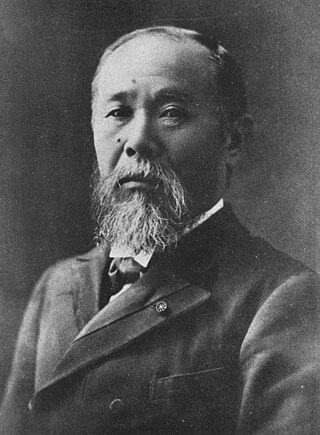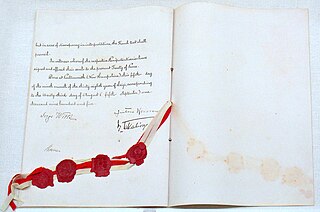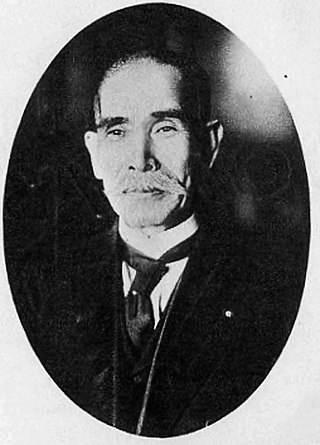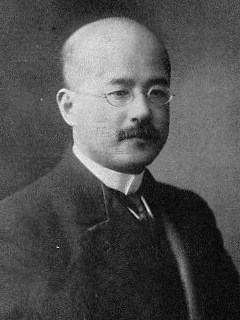
Prince Itō Hirobumi was a Japanese politician who served as the first prime minister of Japan from 1885 to 1888, and later from 1892 to 1896, in 1898, and from 1900 to 1901. He was a leading member of the genrō, a group of senior statesmen that dictated policy during the Meiji era. Even out of office as head of government, Itō continued to wield vast influence over Japan's policies as a permanent imperial adviser (genkun) and frequent president of the emperor's Privy Council. A staunch monarchist and leading proponent of Japan's Westernization, Itō favored a large, all-powerful bureaucracy that answered solely to the emperor, and opposed the formation of political parties.

The Treaty of Portsmouth is a treaty that formally ended the 1904–1905 Russo-Japanese War. It was signed on September 5, 1905, after negotiations from August 6 to August 30, at the Portsmouth Naval Shipyard in Kittery, Maine, United States. U.S. President Theodore Roosevelt was instrumental in the negotiations and won the Nobel Peace Prize for his efforts, the first ever American recipient.

Prince Yamagata Aritomo was a Japanese politician and general who served as prime minister of Japan from 1889 to 1891, and from 1898 to 1900. He was a leading member of the genrō, a group of senior statesmen who dominated politics during the Meiji era. As the Imperial Japanese Army's inaugural Chief of Staff, he was the chief architect of the Empire of Japan's military and its reactionary ideology; some historians consider him the "father" of Japanese militarism.

GensuiCount Terauchi Masatake, GCB, was a Japanese military officer and politician. He was a Gensui in the Imperial Japanese Army and the Prime Minister of Japan from 1916 to 1918.

Yamanashi Hanzō was a general in the Imperial Japanese Army, Army Minister and Governor-General of Korea from 1927 to 1929.

The Governor-General of Chōsen was the chief administrator of the Government-General of Chōsen from 1910 to 1945.

Viscount Suematsu Kenchō was a Japanese politician, intellectual and author who lived in the Meiji and Taishō periods. Apart from his activity in the Japanese government, he also wrote several important works on Japan in English. He was portrayed in a negative manner in Ryōtarō Shiba's novel Saka no ue no kumo.

Count Hayashi Tadasu, GCVO was a Japanese career diplomat and cabinet minister of Meiji-era Japan.

Viscount Kodama Gentarō was a Japanese general in the Imperial Japanese Army and a government minister during the Meiji period. He was instrumental in establishing the modern Imperial Japanese military.

Viscount Kawamura Kageaki was a field marshal in the Imperial Japanese Army.

ViscountTakashima Tomonosuke was a samurai of Satsuma Domain, general in the early Imperial Japanese Army, and a cabinet minister in Meiji period Japan. Part of Sophia University in Tokyo is located on the site of his house.

Count Hideo Kodama, was a politician, and wartime cabinet minister in the Empire of Japan. He was the eldest son of famed Russo-Japanese War general Kodama Gentarō, and his wife was the daughter of Prime Minister Terauchi Masatake.
General Sir Charles John Burnett was a British Army officer at the end of the 19th century and during the early years of the 20th century.

Viscount Ōshima Yoshimasa was a general in the early Imperial Japanese Army during the First Sino-Japanese War and the Russo-Japanese War. His great-great-grandson, Shinzō Abe was Prime Minister of Japan.

Viktor Viktorovich Sakharov was a Russian lieutenant general and Imperial Minister of War (1904–1905).

Count Yoshikawa Akimasa was a Japanese bureaucrat, statesman and cabinet minister, active in Meiji- and Taishō-period Japan.

Baron Inoue Hikaru was a general in the Imperial Japanese Army during the First Sino-Japanese War and Russo-Japanese War.

Baron Samejima Kazunori was an admiral in the early Imperial Japanese Navy.

Viscount Ōshima Hisanao was a general in the early Imperial Japanese Army.

Prince Yamagata Isaburō was a Japanese politician, cabinet minister, and Japanese Inspector-General of Korea. His wife was the daughter of Katō Hiroyuki.


















